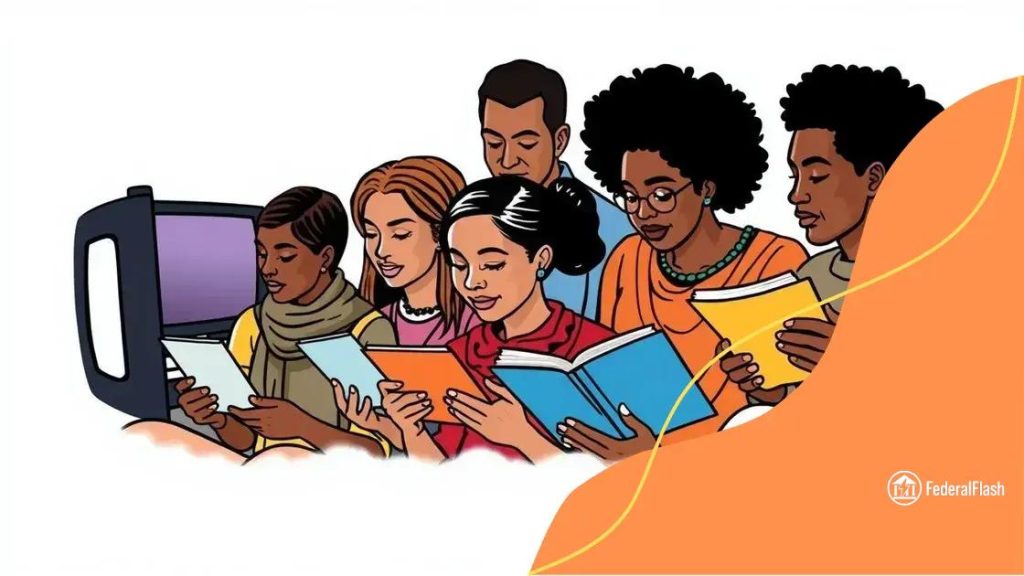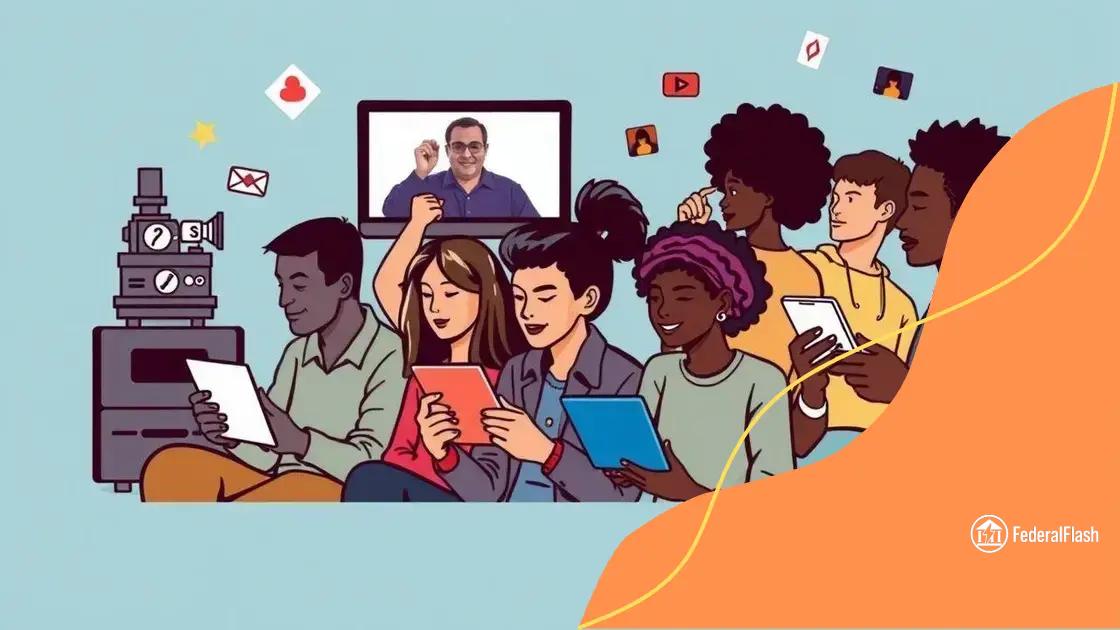Shifts in cultural values and their reflection in media

Anúncios
Shifts in cultural values and their reflection in media demonstrate how evolving societal norms influence storytelling, representation, and the narratives presented across various platforms, fostering a more inclusive media landscape.
Shifts in cultural values and their reflection in media are bringing intriguing changes to how we perceive ourselves and our stories. Have you noticed how certain themes resonate differently today compared to a decade ago? Let’s explore this evolution together.
Anúncios
Understanding cultural values and their evolution
Cultural values shape our identities and influence our perspectives. Understanding cultural values and their evolution helps us navigate the complexities of modern society. They reflect what we believe, value, and aspire to be in life.
The Core of Cultural Values
At the heart of every culture are values that define behaviors and traditions.
- Family structures and roles
- Education and knowledge importance
- Viewpoints on work and success
These values can vary widely across different societies, and they help us understand one another better.
Anúncios
Factors Influencing Cultural Evolution
The evolution of cultural values is often influenced by major events and changes in society. These can include:
- Technological advancements
- Social movements
- Economic changes
Each of these factors contributes to shifting values over time. For instance, the rise of the internet has transformed how we connect and communicate.
Moreover, as globalization spreads, cultures mix and adapt. This blending often leads to new values replacing or merging with traditional ones. Understanding this dynamic helps us appreciate the diversity of human experience.
The impact of globalization on cultural narratives
The impact of globalization on cultural narratives is profound and far-reaching. As cultures collide and intertwine, narratives shift and evolve, reflecting the complexities of a connected world.
Changing Storytelling Techniques
Globalization influences how stories are told across different cultures. With the rise of the internet, storytelling techniques have become more varied.
- Incorporation of digital media
- Emphasis on diverse perspectives
- Multilingual storytelling
This diversity enriches narratives and enables voices from around the world to reach new audiences.
Blending of Cultural Elements
As globalization spreads, elements from various cultures blend together. This blending often leads to unique stories that reflect a mixture of traditions and values. For instance, films and literature increasingly incorporate themes from multiple cultures.
The result is a rich tapestry of cultural narratives that challenge traditional boundaries. New genres emerge, combining different cultural elements to create fresh stories. This evolution encourages innovation while preserving essential aspects of each culture.
Moreover, exposure to global narratives influences local storytelling. Writers and creators are inspired by the stories they encounter from other cultures, which leads to an exchange of ideas and themes. This exchange can promote understanding and empathy among diverse groups.
How media reflects changing attitudes

Media plays a crucial role in reflecting changing attitudes within society. It shapes how we perceive the world around us and also mirrors our evolving values.
Representation in Media
One of the most significant ways media reflects changing attitudes is through representation. Diverse characters and stories help audiences see different perspectives.
- Inclusion of various races and ethnicities
- Gender representation and challenges
- Recognition of LGBTQ+ voices
This representation fosters understanding and empathy, which are essential in a multicultural society.
Changing Narratives and Themes
As attitudes shift, so do the narratives and themes in popular culture. Media content increasingly addresses contemporary issues such as:
- Social justice movements
- Environmental concerns
- Technology and privacy
For instance, films and television shows now explore themes of equality and justice more than ever before. This evolution reflects society’s growing demand for awareness and change.
Furthermore, the rise of social media has given individuals a platform to voice their opinions. This allows for real-time feedback and prompts creators to adapt their storytelling to resonate with current societal values.
Examples of cultural shifts in popular films
Examples of cultural shifts in popular films showcase how society’s values and beliefs evolve over time. These shifts often mirror changes in attitudes toward race, gender, and social issues.
Representation of Diverse Characters
Films are increasingly featuring diverse characters who reflect different backgrounds and experiences. For instance, films like “Black Panther” highlight African culture and showcase black superheroes, empowering underrepresented communities.
- The rise of female-led superhero movies
- Biographical films focusing on LGBTQ+ icons
- Movies that address social justice issues
This representation is crucial as it challenges traditional stereotypes and provides audiences with varied perspectives.
Shifting Gender Roles
Another notable cultural shift is the portrayal of gender roles in films. In the past, many films depicted women as secondary characters. Now, films like “Wonder Woman” and “Mad Max: Fury Road” place women in strong, lead roles, showcasing their strength and complexity.
These changes encourage young girls and boys to see beyond traditional gender norms. As a result, audiences are exposed to more powerful narratives that challenge stereotypes.
Moreover, the storylines have evolved, often exploring themes of equality and empowerment, which resonate with today’s audiences. This reflects a broader societal movement toward gender equality, showing how media can foster conversations around important issues.
The future of media and cultural representation
The future of media and cultural representation is shaping up to be more diverse and inclusive than ever before. As technology evolves, so too do the stories that are told and the perspectives that are shared.
Emerging Technologies in Storytelling
Innovations like virtual reality (VR) and augmented reality (AR) are transforming how stories are experienced. These technologies provide immersive experiences, allowing audiences to engage with narratives on a deeper level.
- VR can place viewers directly in the story
- AR enhances the real world with digital information
- Interactive storytelling allows for personalized narratives
This change opens up possibilities for greater representation, as creators can develop content that explores complex cultural themes and individual experiences more authentically.
Increased Access to Content Creation
In addition, the rise of social media platforms has democratized content creation. Anyone with a smartphone can share their stories, voices, and perspectives with a global audience.
This accessibility empowers underrepresented groups to tell their own stories. People can showcase their culture and experiences, enriching the media landscape with fresh narratives. For example, TikTok and YouTube have become platforms where diverse creators can thrive and influence cultural conversations.
Furthermore, as audiences demand more diverse representations, media companies are responding by prioritizing inclusive storytelling. This shift not only reflects societal changes but also creates a more engaging and relatable viewing experience for all audiences.
FAQ – Frequently Asked Questions about Media and Cultural Representation
How does globalization impact cultural narratives in media?
Globalization blends different cultures, resulting in richer narratives and diverse representation in films and television.
What role does technology play in shaping media content?
Emerging technologies like VR and AR enhance storytelling, allowing for more immersive and interactive experiences.
Why is diverse representation important in media?
Diverse representation reflects varying perspectives, fosters understanding, and empowers underrepresented groups to share their stories.
How can social media influence cultural representation?
Social media platforms enable diverse creators to share their voices and narratives, promoting a broader cultural discourse.